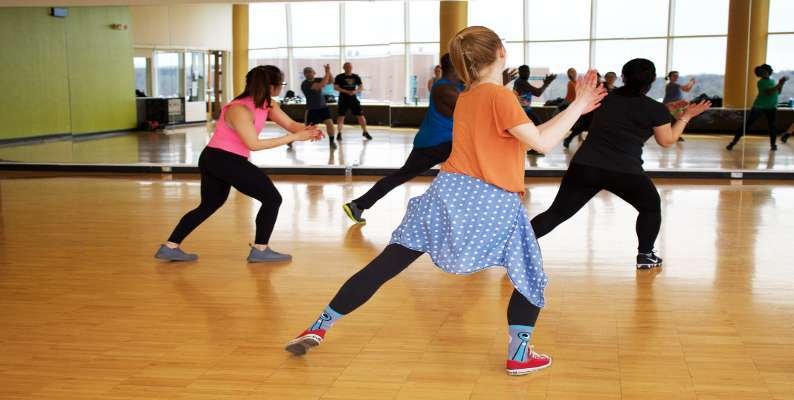There are numerous definitions of physical fitness floating around, most either unclear or confusing. However, physical fitness is more simply defined by true exercise scientists and government sponsored health agencies.
What is Physical Fitness Defined by the 5 Elements That Make it Up
Most government agencies and scientists that specialize in exercise as it relates to health and wellness agree that when it comes to your health, there are 5 elements of physical fitness. And I agree that these five elements perfectly answer the question, “What is physical fitness?”
In fact, you can use these 5 elements to assess your own state of physical fitness. These factors give a pretty good idea of how fit and healthy your body is as a whole, or overall.
The 5 Elements of Physical Fitness
- Cardiovascular fitness, which hinges on your respiratory and cardiovascular endurance
- Muscular strength
- Muscular endurance
- Overall flexibility
- Body composition, which encompasses the percentages of fat, bone, and muscle makeup of your body.
We will explore each of the elements of physical fitness a little deeper and see how each relates to your overall health and wellness.

1. Cardiovascular fitness or cardio and respiratory endurance
Most physicians and experts agree that cardiovascular fitness is the foundation of your overall fitness. Both cardiovascular and respiratory fitness are key to the other 4 components of physical fitness.
Cardiovascular fitness is a measure of how well your heart and lungs work together to supply oxygen to your muscles during exercise. Your heart pumps oxygen-rich blood to your muscles, and your lungs take in oxygen and release carbon dioxide.
The more efficiently your heart and lungs work together, the more fit you are. Cardiovascular fitness is important because it helps to keep your heart healthy and reduces your risk of heart disease.
It also helps to improve your lung function and increase your stamina and boost overall energy levels. The day-to-day task that make up our lives depends on cardio fitness.
The most common test for cardiovascular fitness is a “Stress Test”, which involves a treadmill or exercise bike in a physician’s office. You will walk or ride until your heart is pumping harder and faster than normal.
Both blood pressure and breathing are closely monitored to reveal any problems with your blood flow or respiratory system.
See also: Your Own Cardio Equipment
Physical activities that promote better cardio and respiratory fitness are running, walking, swimming, cycling, or any aerobic exercise.
2. Muscular Strength
Muscular strength is the amount of force that a muscle or group of muscles can generate. It is an important component of fitness because it helps to reduce the risk of injuries and to improve performance in both everyday activities and more physical endeavors such as running, jumping, and lifting weights.

All of us need some degree of muscular strength to carry out the common things we do. For instance, lifting household items, moving around and staying mobile, and carrying items to and from.
There are several ways to measure muscular strength, including:
- The number of repetitions you can complete in a given amount of time.
- How much force can you generate, such as pushing against someone’s hand or arm, or pulling down against something or someone else’s strength?
Cardiovascular fitness and strength are usually measured during a certain time frame. However, muscular strength is measured during only one repetition.
People with more muscle strength are more resistant to fatigue and are less likely to experience injuries. For these reasons, muscular strength is an important aspect of fitness.
The most common test to measure muscular strength usually involves some sort of weight lifting activity, or merely pushing or pulling against someone else’s strength.
See also: Increasing Muscular Strength
The best way to improve muscular strength is with anaerobic exercises with dumbbells, barbells, or resistance bands.
3. Muscular endurance
Muscular endurance is the ability of a muscle or group of muscles to repetitively exert force against resistance.
In other words, it’s the muscle’s or muscles’ ability to keep going without tiring.
This is an important component of fitness because it can help you perform activities of daily living, such as carrying groceries or climbing stairs, as well as improve your sports performance.
Muscular endurance and muscular strength are both important factors in overall fitness, but they are distinctly different.
Muscular endurance vs Muscular strength
Muscular endurance is the ability of a muscle or group of muscles to repeat a movement for an extended period of time. Muscular strength is the maximum amount of force a muscle can generate in a single contraction.
Most activities require some combination of both muscular endurance and strength, but the specific demands vary depending on the activity.
Ultimately, both qualities are important for overall fitness and health, and it is advisable to focus on both when developing a workout routine.
When it comes to muscular endurance, there are two types of exercises that are most effective: aerobic and anaerobic.
Aerobic exercises, such as jogging or cycling, work by increasing your heart rate and breathing rate so that more oxygen is delivered to your muscles. This allows you to exercise for longer periods of time without tiring.
Anaerobic exercises, such as weightlifting or sprinting, are shorter in duration but require more effort. These exercises train your muscles to use energy more efficiently so that they can sustain high levels of activity for longer periods of time.
See also: Building Endurance With Rowing Machines
Most people are familiar with muscular endurance testing from their high school gym classes, where they were required to do as many pushups or sit-ups as possible in a minute or two.
However, there are a variety of other ways to test muscular endurance, and some of them are more common than others.
One popular method is the timed hold test, in which the athlete must hold a weight (usually a percentage of their body weight) for as long as possible. Another common test is the repetitions-to-exhaustion test, in which the athlete does as many repetitions of an exercise as they can before becoming too tired to continue.
Regular exercise is one of the best things you can do for your health. It has many benefits, including improving your overall health and fitness, and reducing your risk for many chronic diseases.
MedLinePlus
You can improve your muscular endurance with both aerobic and anaerobic exercise. Try stationary bikes, steppers, elliptical machines, or resistance bands.
4. Flexibility
Flexibility is a vital component of physical fitness. Flexibility refers to the range of motion of a joint or group of joints and a lack of flexibility can lead to joint pain, stiffness, and immobility.
Staying flexible throughout your life is an important element of physical fitness. Without it, daily task can become quite painful, or almost impossible. The ability to move joints through their full range of motion can help to improve posture, reduce the risk of injury, and increase the likelihood of successful rehabilitation from injury.
Maintaining flexibility is a vital part of maintaining healthy muscles and joints. When flexibility goes, back pain, arthritic pain, knee pain, and injuries become common place.
See also: Stretching is Powerful
There are a variety of ways to improve flexibility, such as static stretching, dynamic stretching, and foam rolling. Foam rolling is an effective way to improve flexibility, as it helps to release tension in muscles and improve blood circulation.
5. Body composition
Body composition is an important aspect of physical fitness. It refers to the percentage of fat, bone, and muscle in your body.
- A high percentage of fat can lead to obesity, which can increase your risk of health problems such as heart disease, stroke, and diabetes.
- A high percentage of muscle can improve your strength and endurance.
- Bone density is also important for overall health. Strong bones help to protect your internal organs and provide support for your muscles and joints.
It’s worth noting that how much you weight isn’t your body composition, and knowing a body’s composition is a better indicator of overall fitness than how much you weigh.
That’s becuase your weight doesn’t take into account your Body Mass Index (BMI), your muscle to fat percentage, or your bone density.
Even though the ratio of fat to lean muscle mass is a definite indicator of your fitness level, it takes an evaluation of BMI, strength, endurance, and bone density to accurately assess you overall fitness level.
A high percentage of fat can lead to obesity, which can increase your risk for health problems such as heart disease, stroke, and diabetes.
Maintaining a healthy body composition is important for overall well-being. There are a variety of ways to measure body composition, including skinfold measurements, bioelectrical impedance, dual-energy x-ray absorptiometry (DEXA), and underwater weighing.
To improve your body composition is to improve the other 4 components that make up the definition of physical fitness.
That means that by improving your cardiovascular, strength, endurance, and flexibility, you naturally improve your body composition. These five elements of physical fitness make up your overall health and wellness level.
Conclusion
There are many different components that contribute to someone’s level of physical fitness.
- Cardiovascular endurance is the ability to sustain activity for long periods of time, and is often measured by activities like running or swimming.
- Respiratory endurance refers to the efficiency of the lungs and heart in delivering oxygen to the muscles, and can be improved through activities like cycling or jogging.
- Strength is the ability to exert force, and can be increased through lifting weights or other resistance training.
- Endurance is the body’s ability to withstand prolonged stress, and can be improved by engaging in activities like long-distance running.
- Flexibility refers to the range of motion of the joints, and can be increased through stretching exercises.
- Body composition is a measure of the ratio of fat to muscle tissue in the body along with bone density, and a healthy body composition is achieved through a combination of diet and exercise.
All of these factors contribute to someone’s overall level of physical fitness, and by improving each component, you can improve your overall fitness level.
